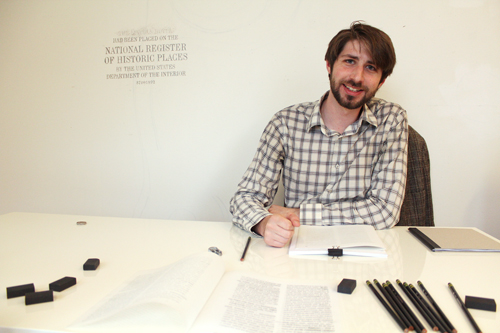
For hour after excruciating hour, Portland State art graduate student Sean Schumacher sits in his studio with pencil and paper listening to the annoying sound of a squeaky air shaft. Schumacher is working on his master’s thesis, an exhibition on the history of Las Vegas that will be on display at the PSU Art Building April 30 through May 9.
A personalized dictionary describing a variety of historical places in Las Vegas, known as The Book of Sand, forms the central piece of the exhibition, which will also feature a slideshow of various historical sites in the famed desert city.
Schumacher grew up in Las Vegas and experienced how rapidly the city grew and changed over time.
“The tourists come and the city seems really permanent for three days,” Schumacher said. “But the sad part is, it really is permanent for just three days.”
Schumacher named the dictionary after a book of the same title by Argentinian author Jorge Luis Borges that tells the story of a book whose language constantly shifts. Schumacher feels this adequately represents the shiftiness of the city as well as his dictionary. The dictionary is written in pencil on a sketch-table with several pencils next to it. The pencils, colored black, symbolize destruction and creation.
“Pencils are normally coupled with an eraser, which are always equal—which is representative of what it’s like to live in a city,” Schumacher said. “There is always creation and destruction.”
Viewers of the exhibition will have an opportunity to erase parts of the dictionary and replace them with their own words, much like Wikipedia, but on physical paper.
Schumacher wants to capture the native experience of Las Vegas by recording the places in several representational ways. For example, as a memorial to a vacant lot, which he discovered was formerly the site of the oldest hotel in Las Vegas, Schumacher created composite dust rings from the lot and will include one in the exhibition.
The slideshow will display images of fenced dirt lots and old buildings going back to the founding of Las Vegas in 1905.
“As a Las Vegan, I’ve become fascinated that I can’t access a lot of my former and current life since it is so difficult to move between these two spaces,” Schumacher said. “So I wanted to record the experience of the city as this really provisional place.”
Schumacher chose the particular slides for his slideshow because Las Vegas preserves its history mainly through signs such as those found in the neon boneyard or in the names of streets.
He believes Las Vegas differs greatly from Portland, partly because of weather, but also because of the attitude of the cities toward their histories.
“Las Vegas abandoned its downtown as a form pretty quickly, so you go out and there are not many crowded streets, and you need a car to go anywhere,” Schumacher said. “Here, there is this strange interest in preserving history and experiencing the city as this negotiation.”
Schumacher plans to either pursue a career in graphic design or teach design classes at a college or university. He hopes to learn more about the history of Las Vegas from the perspective of his viewers.
“Hopefully they’ll get a sense of the city as a place where people live, that needs this history, rather than a round-the-clock bacchanalia [that is, a party], which ends with a mandatory memory wipe at the airport,” Schumacher said.
Sean Schumacher’s The Book of Sand
Art Building
On view April 30 through May 9
Public lecture: May 1, 6–8 p.m.,
Shattuck Annex
Opening reception: May 3 from 5–6 p.m.

